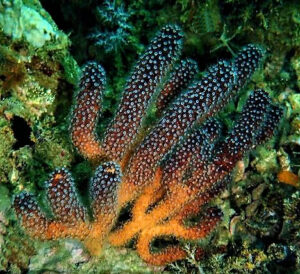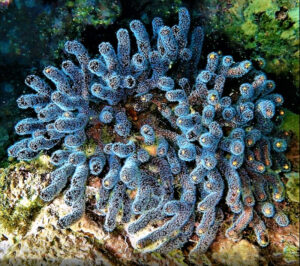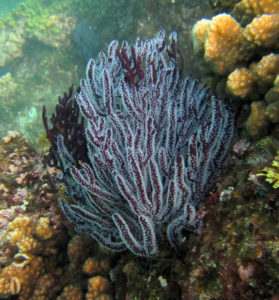Brown Gorgonian, Muricae fruticosa

 Brown Gorgonian, Muricae fruticosa. Underwater photographs taken in Zihuatanejo Bay, Guerrero, March 2018. Photographs courtesy of Ron Woheau, Zihuatanejo.
Brown Gorgonian, Muricae fruticosa. Underwater photographs taken in Zihuatanejo Bay, Guerrero, March 2018. Photographs courtesy of Ron Woheau, Zihuatanejo.
 Brown Gorgonian, Muricae fruticosa. Underwater photograph taken in coastal waters of the greater Los Cabos area, Baja California Sur, May 2018. Photograph courtesy of Bob Hillis, Ivins, Utah.
Brown Gorgonian, Muricae fruticosa. Underwater photograph taken in coastal waters of the greater Los Cabos area, Baja California Sur, May 2018. Photograph courtesy of Bob Hillis, Ivins, Utah.
Phylogeny: The Brown Gorgonian, Muricae fruticose (Verrill, 1869), is an octocoral and a member of the Plexauridae Family of Gorgonians. It is also commonly referred to as the Bushy Gorgonian or Sea Fan.
Morphology: The Brown Gorgonian has a somewhat bushy appearance with reddish-brown branches and white polyps. They reach a maximum height of 90 cm (2 feet 11 inches).
Habitat and Distribution: The Brown Gorgonian is found current-swept areas attached to hard surfaces such as coral, pilings, rocks, kelp forests, and wreckage, in shaded areas such as caves and overhangs, at depths between 6 m (20 feet) and 100 m (330 feet). The Brown Gorgonian have a discontinuous range being found from Punta Eugenia, Baja California northward along the northwest coast of Baja and from the Midriff Islands south the greater Cabo San Lucas area, Baja California Sur within the Sea of Cortez. This species of marine life is extremely tolerant to water pollution.
Diet: The Brown Gorgonian is a nocturnal sessile suspension feeder that captures drifting food in the water column by individual polyps with small tentacles. These nutrients will reach all members of the colony through channels in the gastrovascular cavity.
Predation: The Brown Gorgonian is preyed upon by the Leather Star, Dermasterias imbricata, and snails.
Synonyms: Thesea corosslandi, Muricea fruticosa, Pseudothesea crosslandi
Request for Help: This identification should be considered tentative due to the very remote location of the collection (Latitude 23oN and Longitude 110oW). I have found very little scientific focus on this area of the world and therefore supporting scientific documentation is not available. I welcome additional information on this coral from anyone who cares to contact me.